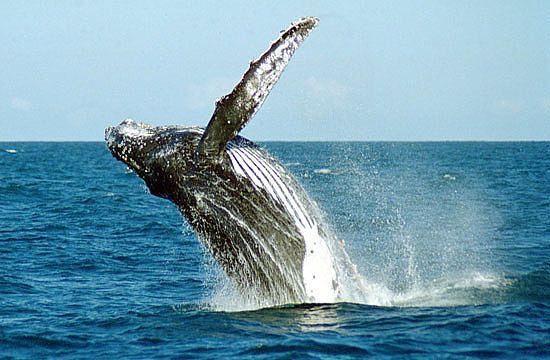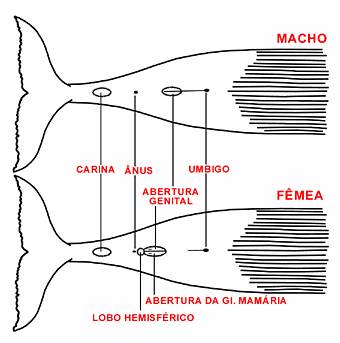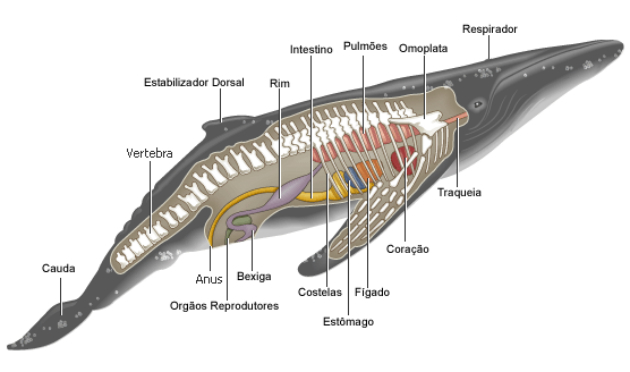Este post também está disponível em:
Português
English

Learn about the characteristics of the Humpback Whale.
Abrolhos National Marine Park is the birthplace of the Humpback Whale
The humpback whale, also called humpback or black whale, belongs to the Balaenopteridae family and is known for its docile temperament, the acrobatics it performs (jumps, head and flippers exposure, etc.) and a developed hyper complex vocalisation system.
Humpback whales – docile and innocent monsters of the sea – are back on the Brazilian coast.
Every year, between July and November, humpback whales (Megaptera novaeangliae) attract attention on the coast of Bahia and Espírito Santo.
The main cradle of the whales is in the Abrolhos National Marine Park, south coast of Bahia and a few kilometres from Caravelas.
During this period, they migrate from the sub-Antarctic waters in search of the mild temperature of the Brazilian coast to mate, give birth and breastfeed their young.
Created in 1983 by Ibama, the Abrolhos National Marine Park is a group of volcanic islands and coral reefs.
Located 36 nautical miles (approximately 70 kilometres) from the coast in the Extremo Sul da Bahia. It is one of the most significant areas of the Brazilian coastline, due to its enormous biodiversity and important ecosystems.
The Abrolhos Bank is home to humpback whales, which make this region their refuge for nursing and reproduction, between the months of July and November. It is the most important breeding area for this species in the Western South Atlantic.
See the map of the Whale Coast.
The Park is essential for the development of fishing activities. Due to the ban on fishing in its boundaries, the corals represent an important breeding ground for fish that increasingly tend to populate neighbouring areas, ensuring the sustainable exploitation of fishing in the region.
Video about the Humpback Whale and the 5 Biggest Whales in the World

Humpback Whale Characteristics
- Family
Balaenopteridae (humpback whale)
- Specific name
Megaptera novaeangliae (Borowski, 1781)
- Common name
Humpback whale, black whale, humpback whale, singing whale, humpback whale
- Distribution
Cosmopolitan species. In summer, it feeds near the poles and in winter it migrates to the tropics to reproduce and raise its young.
It has coastal habits but can also be found on oceanic islands such as Fernando de Noronha and Trindade. In Brazil, it occurs from Rio Grande do Sul to the northeast.
The Abrolhos Bank, in Bahia, is an important breeding area in the Western South Atlantic, and the only one duly proven so far (it is suspected that there may be another on the northeast coast of Brazil).
Currently, in the Southern Hemisphere, there are possibly around 12,000 individuals, divided into 7 distinct populations.


- Weight, measurements and characteristics
Robust body. Adults generally measure between 12 and 16m and can weigh more than 40 tonnes.

Black back with irregular white spots on belly. Pectoral fins and ventral part of caudal fin vary from total black to total white, with intermediate patterns.
Central keel on the head, which is rounded and full of callosities or tubercles, typical of the species, which may be covered with barnacles and whale lice. The dorsal fin is small, falcate or flattened, situated on a small hump.
The caudal fin is butterfly wing-shaped, with jagged edges. Pectoral fins very long, corresponding to 1/3 of the body length, with jagged edges.
It has 250 to 400 pairs of dark grey or brown fins. It has 12 to 36 ventral folds, which extend to near the genital opening.
- How they are born and how long they live
Males vie for females with fighting among themselves and aggressive behaviour. In breeding areas the most commonly observed group structure is pairs of females with young accompanied by one or more males called escorts.
Sexual maturity is reached at approximately 11m. Gestation lasts about 1 year. Females give birth to a single cub which at birth measures about 5m and weighs 1.5 tonnes. Breastfeeding lasts from 6 to 10 months.
The average interval between cubs is 2 years. It can live for at least 40 years.
- Behaviour and habits
It swims alone, in pairs or trios but can form larger temporary groups in feeding and breeding areas. It usually jumps, hits the surface of the water with its fins and head, and because it is curious it often approaches boats.
It can remain with its tail, head and pectoral fins exposed on the surface of the water for up to a few hours. It usually projects its caudal fin out of the water before starting a deep dive.
Males often emit song-like sounds that can last from 6 minutes to over an hour in breeding areas to attract and court females. The song is composed of several phrases that are repeated identically for hours at a time.
Small variations in humpback song are only realised when heard year after year: apparently, each year the whale adds a new phrase to the song. Different populations of humpback whales perform different songs. They exhibit complex social behaviour.
When harassed, they may release bubbles from their blowhole into the water and emit a trumpet-like noise as a warning signal. It sprays out in the shape of a balloon and can reach a height of 3m.
- Feeding

Mainly in summer, in cold waters. It feeds on krill, copepods and small fish that form shoals. They have a number of highly specialised feeding techniques.
- Individual Identification
The colouration of the ventral part of the caudal fin and the shape and trimming of the edges create a unique tail design in each individual. The shape, markings and scars of the dorsal fin also make it possible to identify distinct individuals.
- Natural Enemies
Orcas (Orcinus orca), false killer whales (Pseudorca crassidens) and possibly large sharks (Family Carcharhinidae).
- Threats
Due to their coastal habits during their migratory periods (July to December) the humpback whale suffers from strong anthropogenic pressures such as accidental catches in fishing nets, collision with boats and ships, pollution of the seas and the destruction of their habitats.
Another potential and imminent threat is the increase in whale-watching tourism on the Abrolhos Bank, which, if done irrationally and uncontrolled, can seriously harm humpback whales.
The oil activity in the Abrolhos Bank region and adjacent areas is a cause for concern regarding future impacts on the whale population. There are records of catches in ocean drift nets for the southern and southeastern regions of Brazil.
- Humpback Whale Corner
Scientists who have been studying humpback whales for five years off the Brazilian coast have discovered that the sound emitted by this mammal during mating changes every year.
According to the researchers, the song is complex, and the discovery that the notes change from one season to another leads them to believe that the sound emitted by whales varies in different regions of the world.
The song to attract the female and ward off rivals takes up to 30 minutes, but the male can repeat it for 24 hours without stopping.
Bahia.ws – Tourism and Travel Guide for Bahia, Salvador and the Northeast of Brazil
Know the characteristics of the Humpback Whale




















